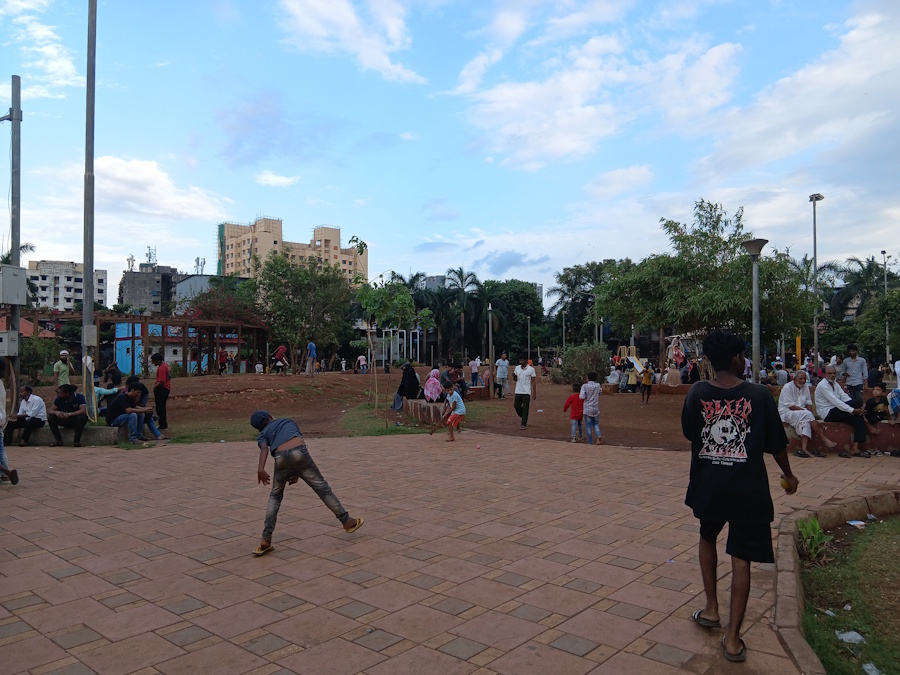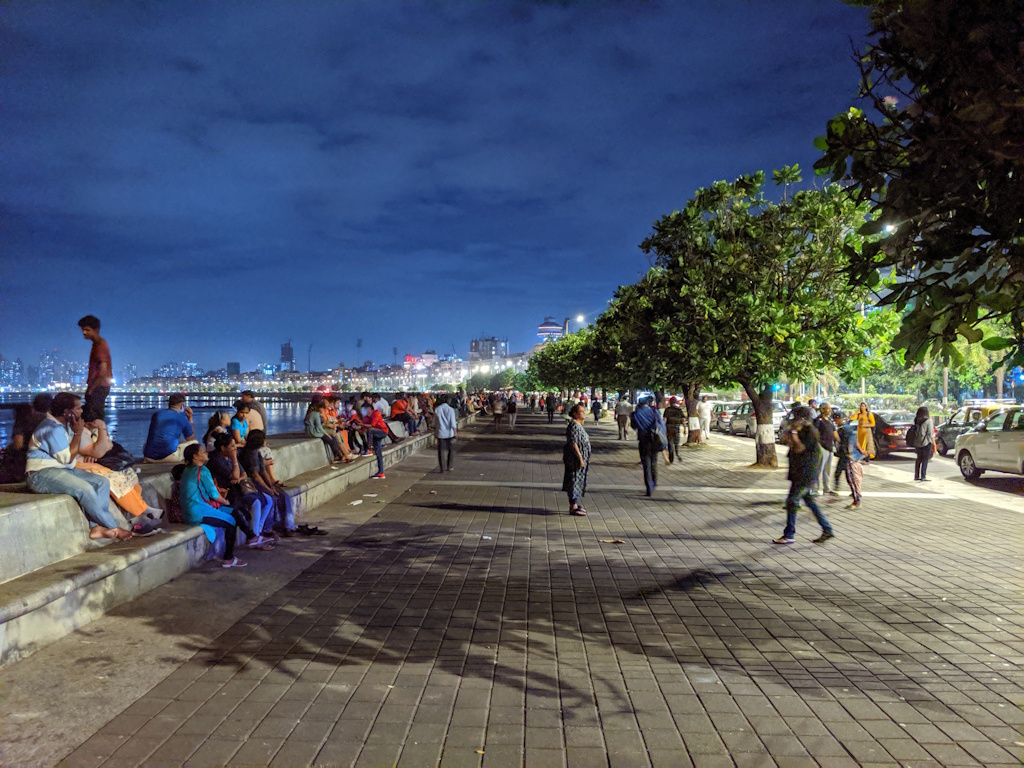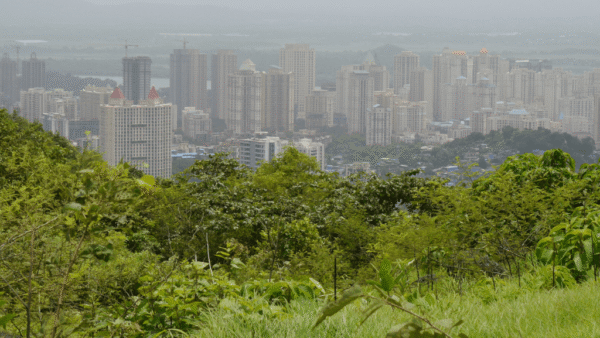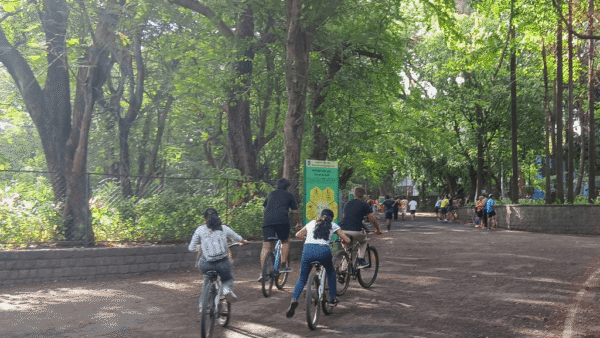On paper, “open spaces” like recreation grounds, playgrounds, and gardens sit inside tidy boxes in Mumbai’s Development Plan. In reality, those boxes keep getting redrawn as Floor Space Index (FSI) rules are tweaked and “amenities” are relocated or redefined. Somewhere along the way, those in charge of Mumbai started treating land like a vault and open land became the new gold. When the government behaves more like a builder’s representative than a people’s representative, the outcome is predictable: Public land drifts into private hands, quietly and steadily.
This is true of water bodies too—lakes, tanks, creeks, and the Arabian Sea—but they deserve their own piece in a city built on water. This essay stays with land-based open space. Mumbai is a city of more than 20 million with roughly 1.2 square metres open space per person—literally the size of a single bed shared between two. Contrast this with London’s 32 square metres, New York’s 27 square metres,[1] and Singapore’s 39 square metres per person.[2]
Mumbai’s numbers are not improving. In fact, projections suggest they will fall further as density rises under current rules and policies that are determined to usurp or construct on available open spaces. Even the accounting of open spaces is duplicitous—ecologically sensitive, inaccessible areas are categorised as “open spaces” though most Mumbaikars cannot even reach them.
Open spaces are vanishing in front of our eyes. Perhaps the most striking recent example of the vanishing commons is the Mumbai Coastal Road. Sold as a futuristic solution to traffic congestion, this nearly Rs 14,000-crore project[3] has concretised and re-segregated the city’s waterfront for generations to come. It caters almost exclusively to private four-wheelers—a small percentage of the city’s commuters—while excluding buses, two-wheelers, pedestrians, and cyclists. This is effectively stealing a public asset for private gain.
The South Mumbai paradox
Citizens are not blameless. Most of us do not ask for much, so we get even less. And those who demand—do get. Consider the new open land along the Coastal Road where an elite lobby has been pushing for a romantically named “coastal forest.” It sounds lovely. Who doesn’t like trees? But look closely and the logic is clear. It is to soften the view from their plush balconies, keep the crowds out, and preserve exclusivity.

Photo: Nikeita Saraf
This is being promoted in the interests of all of Mumbai but it is greenwashing, destroying the chance to build a generous, open and connected waterfront for everyone. While it is undeniable that Mumbai needs more green and open spaces, do we want a “forest” neatly tucked away in an exclusive area?
The decisions about this “coastal forest”[4] and the Mahalaxmi Racecourse[5] will shape how Mumbai treats open land for a generation to come. Both are lazy and dangerous ideas that waste extraordinary opportunities. On the coast, the chance for continuous access, sea air, room for festivals, sport, and evening walks is being traded for enclosed, landscaped islands to look at, not live in. At the Mahalaxmi Racecourse, a rare and natural lung is being carved up, with a portion becoming a hard-edged “sports facility” with concrete underfoot and basement parking below—a parking lot masquerading as a park!
Every city needs its commons—Hyde Park, Central Park, Cubbon Park—preserved in entirety, not parcelled into bits. Mumbai risks losing one of its last. A better path is obvious: stitch the coast and the racecourse into a single, car-free network of maidans, gardens, sports fields, and promenades—true public space—open to everyone, forever.
Forests and all things green
While Breach Candy residents lobby for a “forest” outside their windows, the Malabar Hill Forest[6] is a revealing irony: A site with timed entries, tickets, and a path that views the forest from above rather than within. It’s good that it exists, it’s sad that access is so controlled (ironically, this short walkway for people generates more revenue than the ₹14,000-crore toll-free Coastal Road for cars). And next door, the Hanging Gardens face years of disruption and possible closure for infrastructure work, threatening ancient trees and a beloved neighbourhood landmark. This brittleness shows how easily our open spaces network can be disrupted, prioritising engineering over ecology.
Now, consider Aarey Forest spread over 3,000 acres as Mumbai’s green lung[7] alongside the Sanjay Gandhi National Park. The car shed of Metro 3 was sited here despite protests. Thousands of trees were felled causing biodiversity loss and long-term damage to a vital forest corridor. Cutting a forest edge weakens the whole — and the city it protects from heat and floods. Meanwhile, the Kanjurmarg Forest has become a dump yard[8] contradicting the BMC’s claims of the lack of dumping space even as it plans to accommodate those displaced from Dharavi in Deonar dumping ground.
Moving north, the proposed Versova to Bhayander Coastal Road extension—a Rs 22,000-crore concrete behemoth[9]— comes with a devastating mangrove bill: roughly 9,000 trees to be cut and nearly 50,000 to be affected.[10] The official reports admit permanent impact over eight hectares and some “temporary” damage—a fallacy in tidal ecosystems. They are trading flood buffers for shaving driving time when climate change demands precisely the opposite. Simple alternative solutions exist but are dismissed as “anti-development.”
Elsewhere, the city has seen the script such as reclamations that promised promenades but were fenced. Or the open space at Bandra Reclamation, long used as a casting yard, that was supposed to be returned to the people. Two and a half decades later, this prime 24-acre site has been allocated for luxury development worth thousands of crores—a clear transfer of public open space to private hands.
At Bandra-Kurla Complex (BKC), the state is adding a cultural centre on previously reserved open grounds, while simultaneously removing 13 kilometres of cycle tracks to widen roads—more built-up, disappearing open spaces and less room for people to walk, cycle and play.

Photo: Wikimedia Commons
Dharavi, Eastern Waterfront, and more
The Dharavi Redevelopment Project, positioned as urban renewal, is fundamentally a real estate deal involving displacement and privatisation of public land. Officially covering about 600 acres, Dharavi’s footprint[11] extends through allied land grabs—saltpans, dairy lands, railway plots, even plans for reclaimed parts of Deonar. These are public assets with alternative public futures being consolidated into a saleable real estate package for a private entity. Many “ineligible” residents are relegated to the city’s margins while the new Dharavi will likely rise as a high-FSI enclave with few ground-level open spaces. The Slum Rehabilitation Authority (SRA) model’s loopholes have ignored essential civic and open spaces. Instead of treating land only as real estate, Dharavi could have been rebuilt, keeping public land public, into a human-scale, 15-minute city.
Or consider the Eastern Waterfront.[12] For decades, Mumbaikars dreamed of yet another front to the sea after the dock activity declined. Instead, land parcels here are eyed for high-end real estate, not public commons.
These mega projects on land (and sea) are not by accident but deliberate and misplaced priorities. The Coastal Road is not an anomaly but part of a pattern of relentlessly building mega projects blind to their context. The Navi Mumbai International Airport will obliterate over 100 hectares of mangroves and 400 hectares of mudflats—natural flood sponges. The Mumbai–Ahmedabad Bullet Train cuts through over 30,000 trees, 22,000 mangroves, and cleaves tribal lands.
Each project is argued in isolation, ignoring the cumulative erasure of vital ecosystems. This “development” model is addicted to scale and spectacle, lacking an integrated response to climate, ecology, and human need. This trend of mega-projects claiming our commons is across India: Delhi’s Central Vista,[13] Amaravati’s masterplan,[14] Bengaluru’s vanishing lakes.[15] Urban land is seen as a commodity, not a shared resource. Mumbai’s fragile geography on reclaimed land, facing rising sea levels, makes the loss of its buffers and sponges particularly perilous.
The small thefts add up too. We are losing small parks that anchor neighbourhood life. Patwardhan Park in Bandra[16] and Pushpa Narsee Park in Juhu[17] faced pressure to be converted to car parks, permanently paving green spaces or turning them into fenced podium gardens. Such localised parks are the daily lungs for millions, vital for children’s play and exercise for the elderly, and community connection. They also act as crucial sponge zones in a flood-prone city, yet they are treated as afterthoughts or real estate reserves.
This mirrors the car problem. We keep building for cars and the remaining open space is used to store them. Roads become de facto open spaces for parking because there’s nowhere else. “Development” often means less space for people, more space for cars, while the last natural sponges are paved over.

Photo: Wikimedia Commons
Policy as lever and loophole
Land use and development policies act as both lever and loophole. The Slum Rehabilitation (SRA) rules, now a city-wide redevelopment tool, prioritise FSI and developers’ profits over essential open spaces and other amenities. The DCPR Regulation 33(11) allows high FSI for “permanent transit camps” that can become dense, sale-linked projects with minimal public realm in neighbourhoods, causing loss of light, air, and trees—a public health issue.
FSI has become currency, with “loading” and “bonusing” promising more homes but creating vertical pressure cookers without proportionate infrastructure and ground-level open space. We celebrate podium “amenities”—gyms, gardens, playrooms stacked above multi-storey parking—while the ground becomes a maze of ramps and gates. These are private comforts, not public commons.
It’s a myth that Mumbai has no space, that every square metre must be monetised. This scarcity is created by policy choices that repeatedly hand over public land to private hands while neglecting the true commons. The real luxury Mumbai can afford is the ability to breathe, walk, gather, and coexist with nature. It’s ensuring a child in Dharavi, a pensioner in Dadar, and a jogger in Malabar Hill all deserve access to safe, beautiful open spaces.
Space is luxury. We are paying more for space that used to be shared, often sold back to us as “amenities” with swipe-card access—a club, not a city. True luxury in Mumbai is the right to step out and breathe.
Ways forward
Mumbai’s future depends on how we treat its last commons. We must:
- Protect what remains: Safeguard mangroves, wetlands, floodplains, and reserved open lands from diversion or encroachment. These are not buffers—they are infrastructure.
- Reclaim and repurpose: Convert disused mills, vacant plots, and marginal lands into public spaces. Restoration must be real, not rhetorical.
- Prioritise accessibility: Open space should be walkable, inclusive, and free from gates or elite capture. If it’s not usable by all, it’s not public.
- Integrate planning: Link coastlines, forests, parks, and maidans into a coherent civic network. Treat open space as essential infrastructure—on par with transport and housing.
- Fix the rules: Align incentives with outcomes. Planning norms must reward ground-level openness, pedestrian safety, and genuine transition in redevelopment.
- Count honestly: Stop inflating metrics with inaccessible land. Transparent measurement is the first step toward equitable planning.
The future depends on the policies of today. When it rains, the city tells us to stay home. That is not resilience; that is retreat. A resilient Mumbai would breathe with working drains and permeable ground, protected mangroves and maidans, added shade, and accessible waterfronts.
We must plan for the next century with a vision: A continuous coast, linked maidans, protected natural buffers, and a thriving street culture. If we measure success by road size, we lose the city’s very foundation. If we measure by time spent outside, together, in clean air, we may yet reclaim our city.
Unfortunately, open spaces in Mumbai feel like outer space—distant, unreachable, and not for everyone. Mumbai does not need more enclaves; it needs commons — open, ordinary, everyday.
Alan Abraham is co-principal of Abraham John Architects and the co-founder of Bombay Greenway, a not-for-profit initiative reimagining Mumbai’s public realm. While his practice is known for high-end interiors and private commissions, Alan is equally engaged in civic projects and urban advocacy, with a focus on parks, open spaces, and sustainable mobility. The firm’s work is guided by the belief that design must serve people and place, and that public land must remain a shared resource. He writes on cities, design, and the future of urban living.
Cover photo: Marine Drive, Mumbai. Credit: Wikimedia Commons




